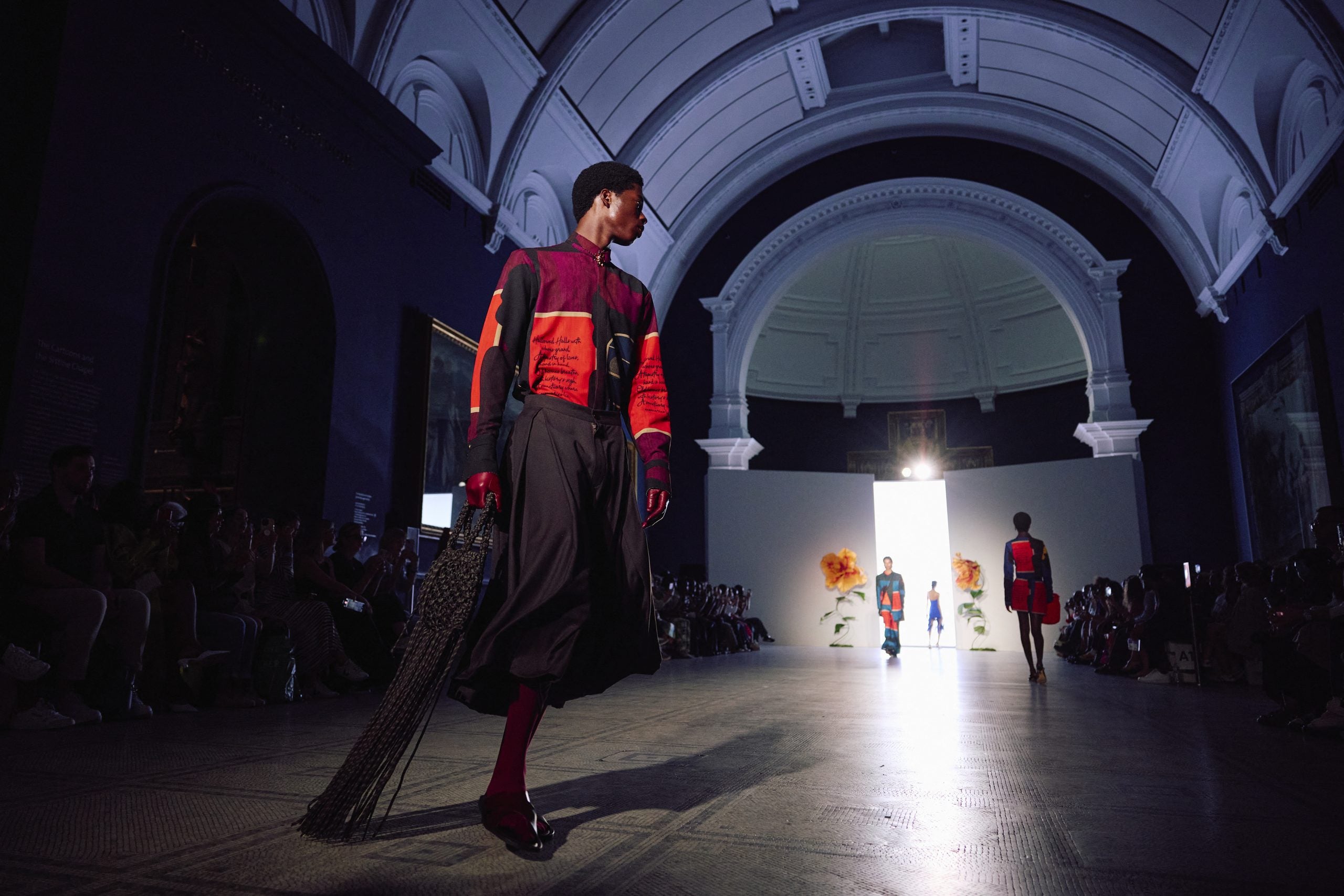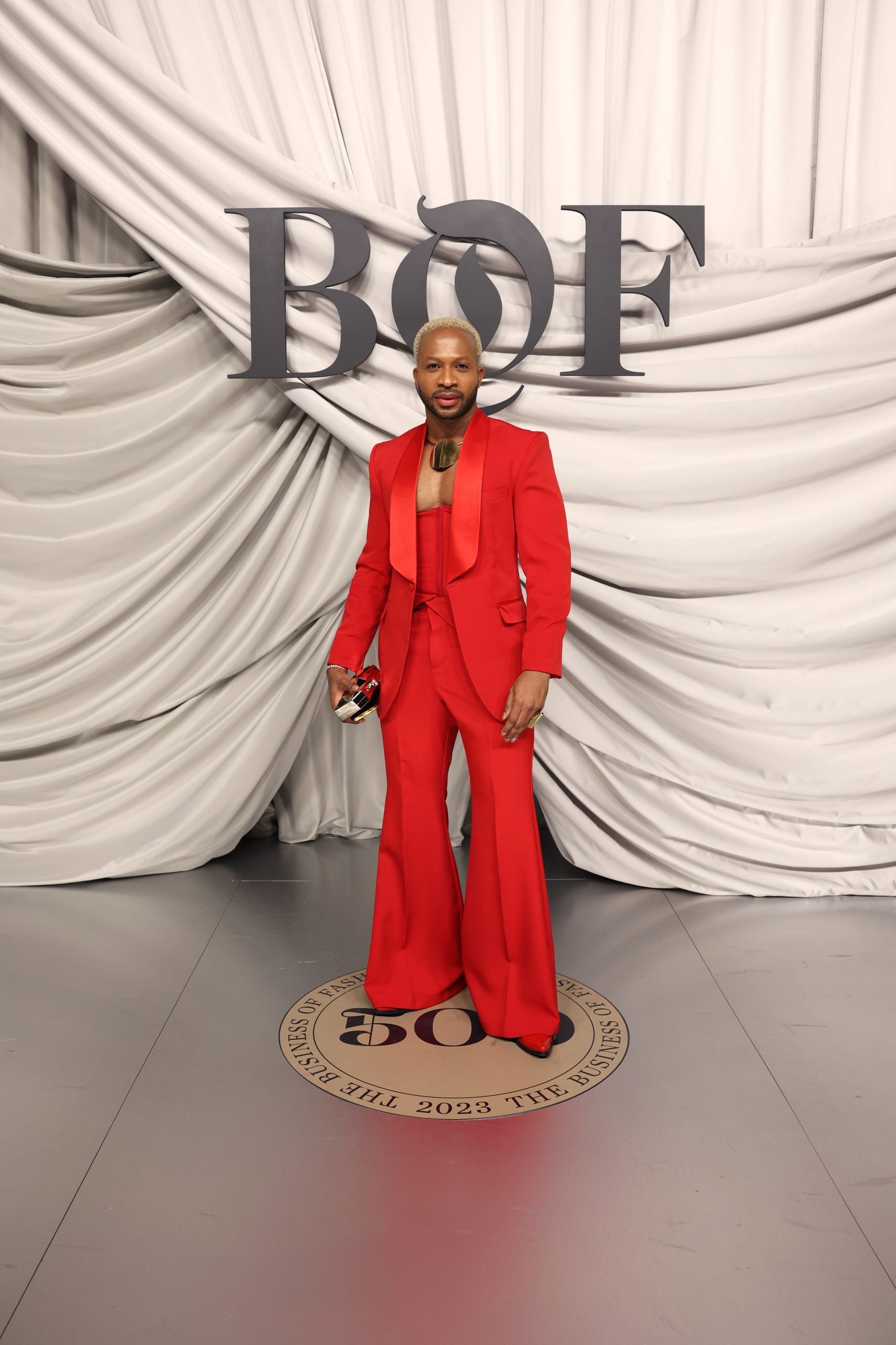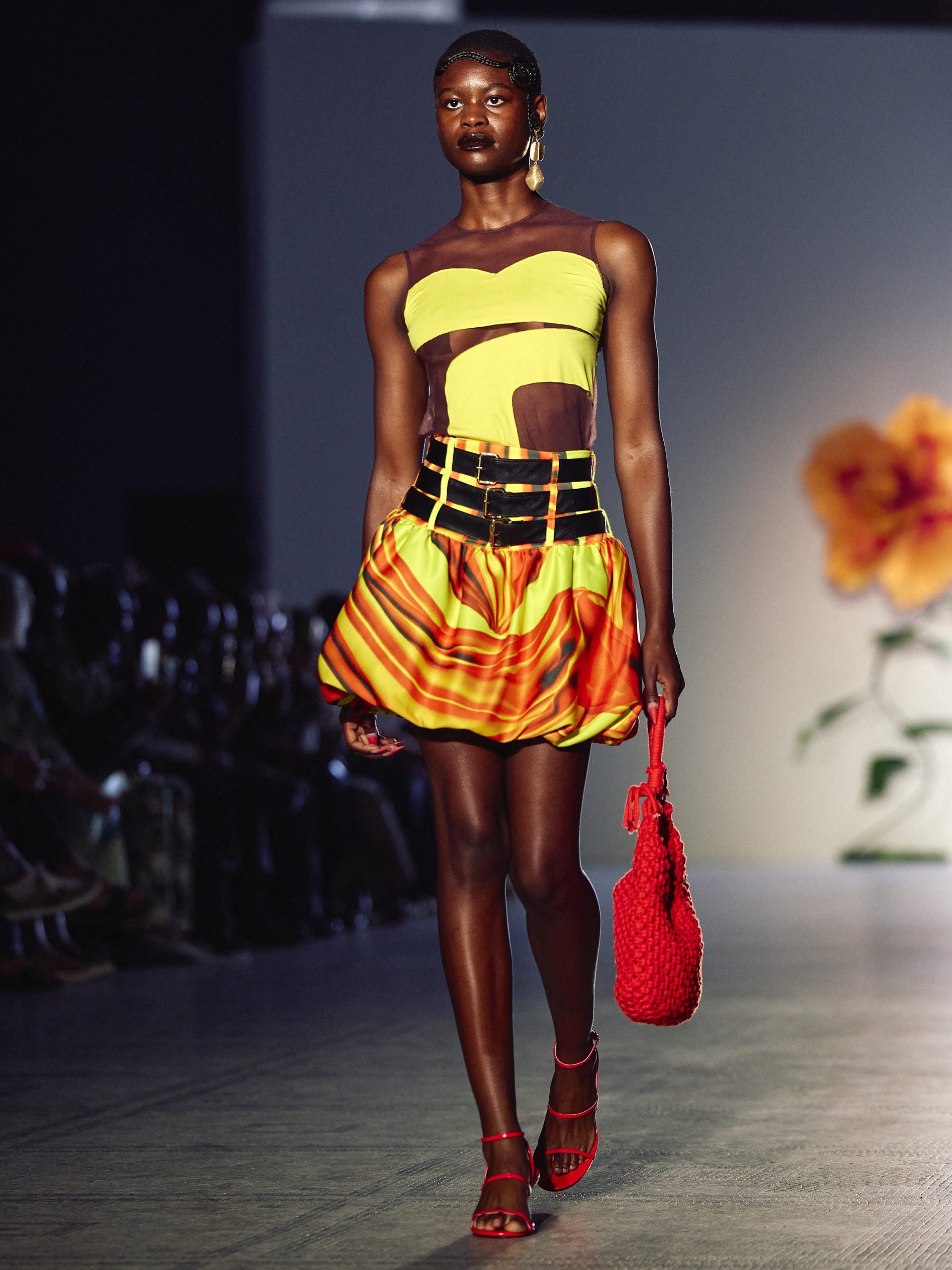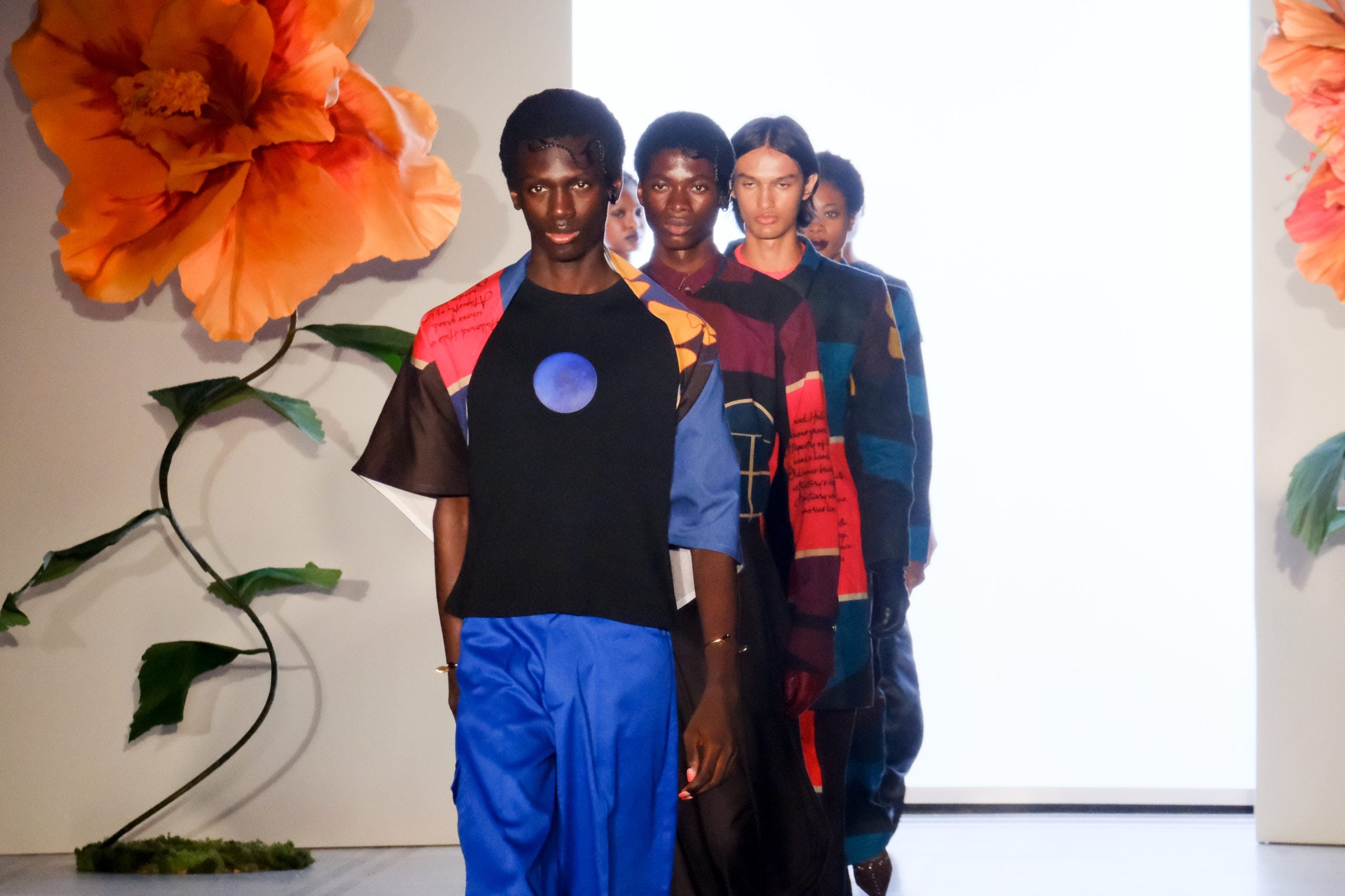
Adebayo Oke-Lawal is arguably one of the most impressive designers of the moment. As the founder and creative director behind Orange Culture, Oke-Lawal who is originally from Nigeria has shown he is capable of evoking change in society. He did so while ushering in a new perspective of menswear–he often challenges societal views of masculinity and androgyny while creating a path for newer waves of design talent to express their creativity without bias.
From childhood, it was clear to Oke-Lawal that he wanted to be a fashion designer, he credits this to the exposure his stylish family gave him. “I remember my parents [would] bring Argos magazine back to Nigeria. I [would]l use the Argos catalog to sketch with [a] friend.” He notes that he would often make sketches of humans too. For him, he says this is what brought him joy as a child.
Watching his mother and sisters dress up in colorful clothing was a source of inspiration for the designer too. “The major thing that drew me to fashion was that I felt out of place, and there was a lack of representation within the menswear industry in Nigeria,” he shared in a previous interview with the Council of Fashion Designers of America.
Oke-Lawal started writing too as a teenager and he wrote an article titled “Orange Boy.” It was about being bullied for who he was and his beliefs that weren’t aligned with stereotypes. He urged people to push for their beliefs no matter how many people urged them it didn’t matter. “It became a trending article and people started writing to me, so I thought about how I could create a voice for this body of people like myself. I merged my passion for creating with a story that explored emotionality and vulnerability within men, as well as the beauty in our culture in ways menswear had not,” the designer noted.

With a burning passion, Adebayo found a way to make it happen and though he studied finance, he decided to make fashion work. So he started small—saving up money, working with fashion magazines, interning during fashion week, and with other brands. Oke-Lawal has previously expressed that he is a self-taught designer due to not being able to convince his parents to send him to fashion school. Impressively, he has a Bachelor of Science in finance from the University of Lagos and a Master of Science in international business from Northumbria University reports Business of Fashion. By 2011, he launched his label.
Upon its launch Orange Culture was unlike any brand on the continent, it was a movement according to Oke-Lawal. The brand has deconstructed how rigid masculinity can be viewed and it also offers a fresh look at what it should be through the lens of the designer. It however sparked a controversy but that didn’t him, instead, this motivated him more to push the possibility of what the brand could be further, and now it has become a brand to be reckoned with.
In 2014 the brand was selected as a finalist for the prestigious LVMH Prize. Following this distinction secured stockists that have led to his brand becoming globally recognized such as Browns, The Folklore, and Farfetch. Currently, Orange Culture is available at Moda Operandi, Industrie Africa, Merchants on Long, and more.

In its 15 years of existence, Orange Culture has offered a refreshing perspective on clothing from the continent and produced collections that are acknowledged by countless fashion communities, especially in matters of trends. This feat is impressive given the harsh global fashion market which often leads to the closure of brands that at some point had buzz or acclaim. And for Adebayo Oke-Lawal, it hasn’t been a seamless process.
“It’s not easy at all, and it doesn’t get easier,” he tells ESSENCE. Here he says the issues he chooses to tackle get more complex in various ways because it’s a tough business as a whole. The designer candidly shares the following on the complexity of running a business, the cliche “more money, more problems.” He also shares with acclaim and success he and his team have to regularly make decisions that “either help advance the business or make the work easier.” This level of efficiency is especially needed since he says when running a business in Nigeria the difficulties are quite high.
Part of being in the business of fashion is having to be stylish himself and it’s very interesting to note that he’s a perfect muse to the designs of several Nigerian and African brands. Bayo likes to describe it as an honor to be able to wear these brands. He says for him it’s an honor to be able to support other African brands by wearing them regularly. On his Instagram, he’s worn LFJ, Sisiano Official, Isalè-Èkó, and KORREY which are all brands created by African designers recently.
The designer is delighted to see how his influence also helps boost the visibility of the brands he wears. “I always celebrate every designer’s wins,” he adds. One notion he shares rings loudly: whether he knows the designer personally or not in addition to whether they’re making more noise than him, he still celebrates them. The idea of the crabs in a bucket might pop up for some who critique this logic–however he relishes in the success of others, Oke-Lawal believes that everyone’s positive moments intertwine.
“When something happens, that noise is not just for that person, [it’s] for all of us–it reminds [everyone] that we are here, that we exist, and that we have great stories to tell. [This] reminds them that as Nigerians or Africans we are not just a topic in the industry, we bring something to the table. That we have something that the world appreciates and wants to see,” he expresses. Education initiatives and mentorship programs including The Orange Mentorship are ways that the designer has decided to pour into the next generation of rising fashion designers.
Oke-Lawal’s style as a designer is quite eccentric, like his designs, he loves to don edgy looks, oversized flare pants, and body-cinching corsets, a lack of fear of colors, whether vibrant or neutral. As a whole, anything that blurs the line between masculinity and femininity is what he delves into and supports in his daily outfits.
He recently presented a runway show at the Victoria and Albert Museum for his Spring/Summer 2025 collection titled “A memory: an ongoing of home.” For Oke-Lawal it was a nostalgic experience working on this collection as it not only dives into the memories of people and their connection with home but also features remnants of his memories of growing up alongside his siblings. It also allowed him space to recall beautiful moments he associates with his adolescent home.

“The collection was inspired by the journey people face when trying to migrate or the feeling that [is] evoked when leaving a familiar place and making an unfamiliar one home. It details the effect of migration on people, most times it’s not always rosy, [but] sometimes it’s great,” he explained. The core of the collection spoke to the deep connection and longing for one’s home country that is left behind, according to the designer.
In the collection, Oke-Lawal used a range of traditional textiles like Aso-oke, which is a signature fabric for the brand. Additionally, to wield an emotional and nostalgic impression, the designer created detailed prints and images on the fabrics, some of which show him with his siblings sitting down in their living room decades back watching television. In some of the fabrics, italicized handwriting is subtly emphasized expressing the designers’ plight at romanticizing the longing for home through letters sent by loved ones decades back before the technological advancements that exist at the moment.
The collection features elegant pieces including pleated gowns with flower constructions, intrinsically-tailored floral suits, leather gloves, and mesh-shouldered dresses. It also features the return of their bestselling open-chested suits, fringe dresses, and beaded pants.
In his latest Oke-Lawal introduces the context of curtains as a means to confront the evil stereotypes immigrants face when coming to a new country. He says he was inspired by the idea of curtains because they allow people to have a peak into your life without having a full view.

He expresses that onlookers often judge immigrants without understanding or seeing the full view. “Just looking at the current temperament, immigrants are constantly on the news being talked about, being attacked. It’s always like there is [a] generalization, they don’t see the full view and perceive immigrants in a dangerous way. You can’t judge a home with just a peek,” he explains.
Securing his debut runway presentation at the V&A museum was a momentous occasion for Orange Culture. Especially considering how he would often visit the space years ago as a child. The V&A’s Fashion in Motion series was a free-to-attend presentation that was open to the public.
Oke-Lawal says he is grateful to open the door for other Nigerian designers–and he is equally thankful that the museum welcomed him to showcase his works. “It was an emotional experience, I dreamt about being in this place,” he adds.







